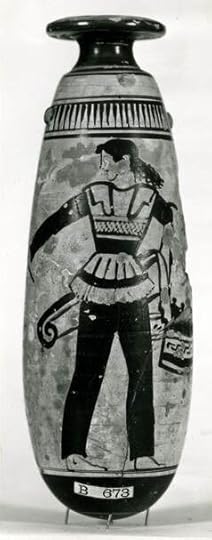Amazon
 The origins of the word Amazon are unknown. The word came unchanged to English in the late 14th century from the Latin and Greek word Amazon.
The origins of the word Amazon are unknown. The word came unchanged to English in the late 14th century from the Latin and Greek word Amazon.Amazons were the female warriors of various matriarchal Scythian tribes which lived about 3,500 years ago in southern Eurasia primarily in the regions between the Black Sea and the Caspian Sea.
Folk etymology from long ago suggested that the word Amazon derived from Greek a- (without) + mazos, mastos (breast); that is, it was thought that Amazon women flattened or removed a breast so that it would be easier to draw a bow when firing arrows. However, this notion has been long discredited. More than a thousand images of Amazon women exist on ancient vases and pottery—none of these images indicate that women have been disfigured.
A more realistic suggestion for the origin of the word is that it may come from Iranian ha-mazan meaning warriors. However, this is conjecture.
Do Amazons still exist? Wonder Woman, the comic book and movie superheroine, is an Amazon warrior. She is Princess Diana, daughter of Hippolyta, Queen of the Amazons. The Wonder Woman character was created in 1941 just in time to participate in World War II.
What about the Amazon River? The Spanish colonists originally called it Rio Santa Maria de la Mar Duce; however, in 1541 it was renamed Amazon after an encounter by Spanish conquistadors with female warriors of the Tapuyas tribe. “Or, as some say, beardless, long-haired male tribesmen” (Online Etymological Dictionary). Other suggestions are that the name of the river is a corruption of a native word in Tupi or Guarani meaning wave.
What about the company that began thirty years ago as an online bookstore and now covers the world with a network of goods and services. Why is it named Amazon? The Britannica website states that Jeff Bezos, the founder, chose the name “primarily because it began with the first letter of the alphabet and because of its association with the vast South American river.”
Image: A portrait of an Amazon warrior on a Greek alabastron (perfume bottle) from around 480 BCE, now at the British Museum. A quiver for arrows is strapped to her back, and in her unseen right hand is a type of battle ax known as a securis.
Reference: Online Etymological Dictionary, https://www.etymonline.com/
Haynes, Natalie. (2020). Pandora’s jar. New York: HarperCollins.
https://www.britannica.com/topic/Amazoncom
Published on June 03, 2022 14:17
No comments have been added yet.



